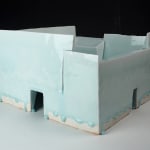Yoshikawa Masamichi 吉川正道 b. 1946
H45.7 x W36.8 x D35cm
Further images
-
(View a larger image of thumbnail 1
)

-
(View a larger image of thumbnail 2
)

-
(View a larger image of thumbnail 3
)

-
(View a larger image of thumbnail 4
)

-
(View a larger image of thumbnail 5
)

-
(View a larger image of thumbnail 6
)

-
(View a larger image of thumbnail 7
)

-
(View a larger image of thumbnail 8
)

-
(View a larger image of thumbnail 9
)

His Kayoh series, initiated in 2009, offers a nuanced exploration of form and meaning. The series title, "Kayoh," holds various translations, one of which is "Gorgeous Effigy." Through his porcelain houses, the artist delves into profound inquiries concerning existence and mortality. Employing Seihakuji (pale blue glaze 青白磁) and Seiji (celadon glaze 青磁) with a deeply human touch, he imbues house-like structures with echoes of tomb architecture from China's Song dynasty. Each piece is meticulously crafted from clay blocks, infusing the fragile medium with a sense of resilience and permanence. Yoshikawa skillfully manipulates glazes to evoke a dynamic interplay of textures and depths within each house. Pooling glaze cascades and azure pools envelop the sturdy forms, resulting in sculptures that beckon with allure while also resonating with an underlying sense of the uncanny.
Kayoh's celadon glaze possesses captivating qualities that transcend mere appearance. Resembling a heavenly fragment gracing the earth, these delicate blue hues reflect the dedication of an artist deeply engaged in pushing the boundaries of ceramic artistry and capturing the essence of sculptural ceramics through porcleain. Yoshikawa's sculptures are complete with feet made of pooled celadon glazes. This slight anthropomorphism is reminiscent of ceramic "feet" that adorn zoomorphic Chinese bronze sculptures from the Tang dynasty, which ultimately serves as a poignant reminder of the artist's profound connection to the rich history and cultural heritage that fuels his creativity.








